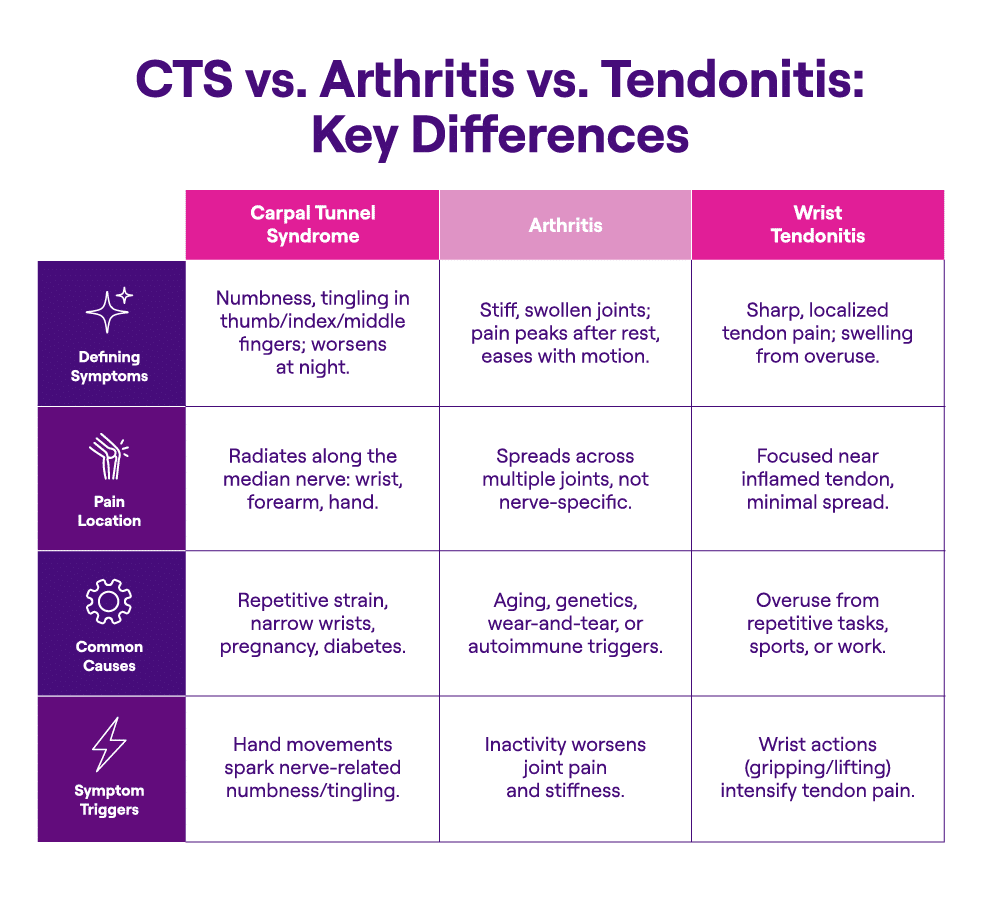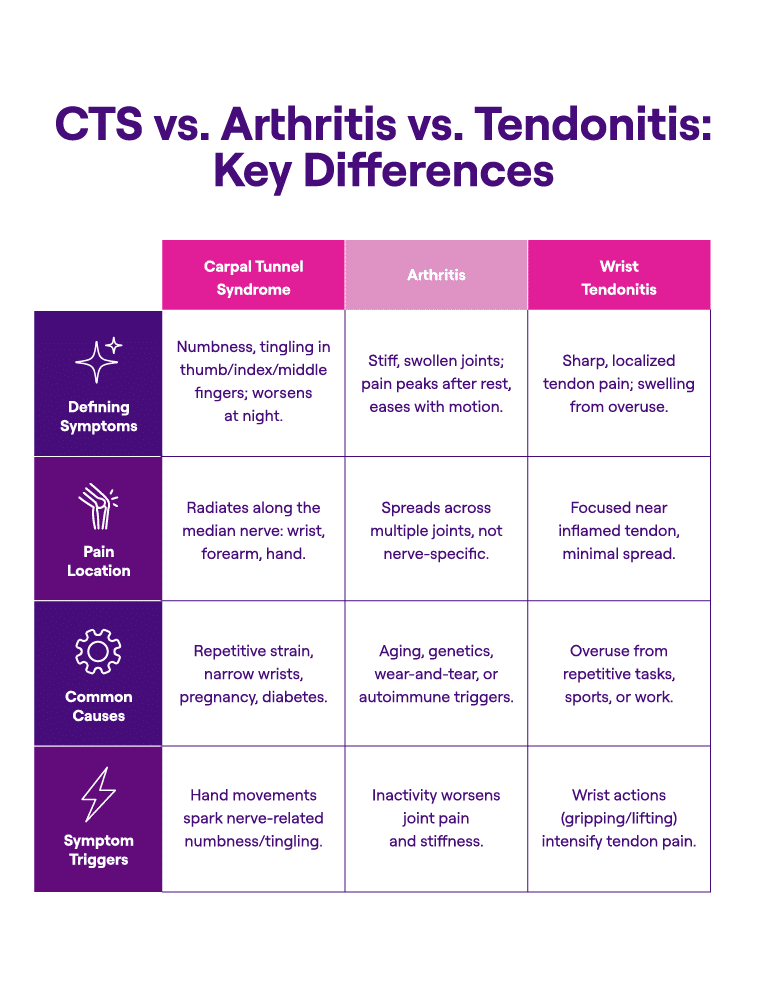Carpal tunnel syndrome (CTS) is a common condition that affects millions of individuals worldwide. It is caused by compression of the median nerve, which runs from the forearm to the hand, leading to a range of disruptive symptoms.
While CTS is commonly recognized as a leading cause of hand and wrist pain, it is not the only condition that produces these symptoms. Arthritis and wrist tendonitis frequently mimic CTS, as these conditions share overlapping signs like pain and discomfort in the wrist and hand. Misdiagnosis can occur when these similarities are misunderstood, delaying appropriate treatment and prolonging discomfort for the individual.
This article explores the differences and similarities among CTS, arthritis, and wrist tendonitis, offering guidance on how to distinguish between these conditions. Additionally, it highlights the role of diagnostic tools like ultrasound in pinpointing the correct cause. To address confirmed cases of CTS, the article also discusses treatment options, including conservative approaches and the minimally invasive carpal tunnel release with ultrasound guidance (CTR-US)*. With accurate information and timely action, individuals can take proactive steps to manage their hand and wrist health and improve their quality of life.
See below for indication and important safety information.
Understanding Carpal Tunnel Syndrome
Carpal tunnel syndrome (CTS) occurs when the median nerve, which travels through a narrow structure in the wrist called the carpal tunnel, becomes compressed. This important nerve is responsible for sensation and movement in the thumb, index finger, middle finger, and part of the ring finger. When the carpal tunnel is narrowed or its surrounding tissues swell, the pressure on the median nerve can lead to noticeable discomfort and functional challenges.
The most common symptoms of CTS include numbness, tingling, or a pins-and-needles sensation in the thumb, index, and middle fingers. Many people experience these symptoms more acutely at night-time or upon waking, which can disrupt sleep. Some individuals report shaking or flexing their wrist to alleviate nighttime symptoms. Over time, untreated CTS can progress, leading to persistent weakness, reduced grip strength, poor hand coordination, and in severe cases, muscle wasting near the base of the thumb.
CTS is often associated with repetitive and forceful hand or wrist movements in occupational settings. In fact, such repetitive strain is highlighted by the CDC’s National Institute for Occupational Safety and Health as a potential contributor to various musculoskeletal conditions. Although repetitive motions are linked to the development of CTS, the contribution of activities like typing remains less certain, with studies presenting mixed findings on its role. Additionally, CTS can be triggered by underlying health conditions, such as diabetes or rheumatoid arthritis. Pregnancy is another risk factor, as fluid retention during this time can increase pressure in the carpal tunnel. Anatomical factors such as naturally smaller wrist structures may also predispose certain individuals to developing CTS.
This condition affects a broad spectrum of individuals. While it is frequently seen in manual laborers and factory workers due to the demands of their work, it is not confined to any single occupational group. Once established, CTS can notably impair daily tasks such as typing, gripping objects, or participating in hobbies. Early recognition and proper management are essential to prevent the condition from worsening and to restore essential hand function.
How Arthritis and Wrist Tendonitis Can Be Mistaken for CTS
Arthritis and wrist tendonitis often present symptoms that resemble carpal tunnel syndrome (CTS), making it challenging to distinguish between the conditions without proper evaluation. Although each stems from distinct underlying causes, they can share overlapping signs such as pain, stiffness, and impaired hand or wrist function. This similarity in presentation sometimes leads to incorrect or delayed diagnoses, prolonging discomfort and complicating treatment.
Arthritis
Arthritis is characterized by joint inflammation, which can affect the wrist and hand. Depending on the type—such as osteoarthritis or rheumatoid arthritis—individuals may experience:
- Throbbing Pain and Stiffness: Unlike CTS, which primarily affects the fingers and wrist, arthritis-related discomfort often involves multiple joints, including the fingers.
- Morning Stiffness: A hallmark of arthritis is stiffness or pain that is most pronounced upon waking and gradually improves with movement throughout the day.
- Reduced Range of Motion: Inflammation can limit mobility in affected joints, creating difficulty in performing tasks like gripping or pinching.
Although arthritis may mimic CTS symptoms, arthritis-related pain is usually broader and not confined to the median nerve’s pathway. This difference can aid in differentiating the two conditions.
Wrist Tendonitis
Tendonitis occurs when wrist tendons become inflamed or irritated, often due to repetitive use or overexertion. Its symptoms can overlap with those of CTS, including:
- Localized Pain and Swelling: Discomfort typically remains concentrated around the inflamed tendon, though it may spread slightly to adjacent areas.
- Activity-Dependent Symptoms: Pain tends to intensify with wrist movement, such as during gripping, lifting, or similar actions.
- Grinding or Popping Sensations: Some individuals experience a crunching or popping feeling with wrist movements—a characteristic more aligned with tendonitis than nerve compression.
In contrast to CTS, where symptoms are tied closely to nerve compression, tendonitis’s manifestations are usually confined to the area surrounding the inflamed tendon.
Why Misidentification Happens
The overlapping nature of these conditions, combined with their shared impact on hand and wrist functionality, makes it easy to misinterpret one for another. Individuals experiencing symptoms like pain, stiffness, or limited mobility might assume they have CTS, especially if their work involves repetitive hand or wrist movements. However, employing treatments designed for CTS on conditions like arthritis or tendonitis may not address the underlying issue, potentially prolonging discomfort.
A thorough evaluation by a healthcare provider is essential. By embracing a detailed understanding of each condition, clinicians can pinpoint the cause of symptoms and recommend appropriate treatments, ensuring a more effective pathway to recovery.
Take A Symptom Survey
Take A Symptom Survey
Symptom Overlaps Among CTS, Arthritis, and Wrist Tendonitis
The similarity in symptoms among CTS, arthritis, and wrist tendonitis can obscure the underlying cause of hand and wrist discomfort. Common signs include pain, stiffness, and limited mobility—symptoms that can be challenging when trying to identify the precise condition behind a patient’s discomfort, but clinicians are equipped with the education and tools to help each patient’s unique case.
This article is not intended to be used as medical advice. Please talk with your doctor.
Common Overlapping Symptoms
Individuals with these conditions frequently report:
- Wrist Pain: Exacerbated by frequent or forceful movements, irrespective of the specific underlying condition.
- Reduced Grip Strength: A diminished ability to hold or manipulate objects, interfering with everyday activities.
- Stiffness or Limited Mobility: Particularly noticeable in the morning or after periods of inactivity.
- Activity-Triggered Discomfort: Symptoms that worsen with repetitive tasks or prolonged use of the hand and wrist.
Although such shared symptoms might initially point to CTS, broader patterns can signal other conditions. For example, arthritis often presents with more generalized joint pain, while tendonitis is marked by localized inflammation.
Importance of Accurate Differentiation
Accurately distinguishing between these conditions is crucial, as each requires a targeted therapeutic approach. Misinterpreting symptoms may lead to ineffective treatments and delayed recovery. For instance, using a wrist brace tailored to relieve nerve compression might not reduce joint inflammation from arthritis or local tendon irritation.
Healthcare providers often rely on a combination of clinical evaluations, patient-reported symptoms, and diagnostic tools such as ultrasound, X-rays, MRI, and nerve conduction studies to accurately identify the root cause of hand and wrist pain. With a clear diagnosis, treatment strategies can be properly tailored, reducing the potential for long-term complications and promoting a faster return to daily activities.
Distinguishing CTS, Arthritis, and Wrist Tendonitis
Although CTS, arthritis, and wrist tendonitis share certain symptoms, each condition bears unique characteristics that facilitate correct diagnosis and effective treatment. Below is a more detailed look at their distinguishing features:
Carpal Tunnel Syndrome (CTS)
- Defining Symptoms: CTS is linked with numbness, tingling, or a “pins-and-needles” sensation in the thumb, index, and middle fingers. Symptoms often intensify at night, sometimes awakening the patient.
- Pain Location: The discomfort may radiate along the median nerve, affecting the wrist, forearm, and hand in a specific pattern.
- Common Causes: Beyond repetitive forceful movements, contributing factors include anatomical predispositions (such as a naturally narrower carpal tunnel), fluid retention (as seen in pregnancy), and underlying conditions like diabetes.
Arthritis
- Defining Symptoms: Arthritis is generally marked by joint pain, stiffness, and swelling. The pain often worsens after periods of inactivity and may ease with movement.
- Pain Location: Typically, arthritis causes more diffuse pain involving multiple joints, not exclusively following the median nerve’s path.
- Common Causes: In addition to age and genetic factors, arthritis can result from wear-and-tear (osteoarthritis) or autoimmune responses (rheumatoid arthritis).
Wrist Tendonitis
- Defining Symptoms: Tendonitis is usually the result of overuse, leading to inflammation of the wrist tendons, accompanied by acute, localized pain and swelling.
- Pain Location: The discomfort is concentrated around the inflamed tendon, with pain that escalates during specific wrist movements.
- Common Causes: Repetitive tasks or overexertion in activities such as sports or certain occupations are typical culprits.
How to Differentiate
Key distinguishing factors include:
- Numbness and Tingling: Predominantly seen in CTS, where the median nerve is affected.
- Pain Distribution: Arthritis commonly presents with more widespread joint pain, while tendonitis remains localized to the tendon area.
- Symptom Triggers: CTS and tendonitis are often exacerbated by specific hand movements, though the former is characterized by neurological symptoms (numbness) and the latter by inflammation-induced pain.
A detailed clinical evaluation, including diagnostic imaging and nerve conduction studies, is essential to pinpoint the correct diagnosis and initiate an optimal treatment plan.


How Diagnostic Ultrasound Helps Differentiate Hand and Wrist Conditions
Diagnostic ultrasound has emerged as an invaluable tool in identifying the underlying cause of hand and wrist pain. It allows healthcare providers to obtain real-time images of soft tissues, including nerves, tendons, and ligaments, thereby facilitating accurate diagnoses.
Benefits of Diagnostic Ultrasound1
- Real-Time Imaging: Observing tissue movement during dynamic activities helps pinpoint abnormalities as they occur.
- Non-Invasive and Painless: Ultrasound offers a safe examination method without radiation exposure or invasive procedures.
- Detailed Soft-Tissue Assessment: Unlike X-rays, ultrasound can capture fine details of soft tissues, making it particularly effective in detecting nerve compression or tendon inflammation.
- Immediate Results: The technique provides instant imaging feedback, which can expedite diagnosis and treatment planning.
Ultrasound Versus Other Modalities
While X-rays are useful for assessing bone structures and MRIs excel in providing high-resolution images, ultrasound strikes an optimal balance by being both rapid and efficient for soft tissue evaluation. Its ease of use and cost-effectiveness make it a first-line diagnostic tool in many instances.1
Treatment Options for Carpal Tunnel Syndrome (CTS)
When CTS is confirmed, treatment usually proceeds through several stages, beginning with conservative management aimed at alleviating symptoms and halting progression. For more severe cases, advanced interventions are considered.
Conservative Approaches
Early-stage treatments may include:
- Wrist Braces: Typically used at night, wrist braces help maintain a neutral wrist position, reducing pressure on the median nerve.
- Physical therapy: Targeted exercises can help by stretching and strengthening the muscles in the wrist and hand.
- Anti-inflammatory Medications: Over-the-counter options such as ibuprofen may help relieve pain and reduce inflammation.
- Lifestyle Adjustments: Modifications in work practices, such as ergonomic rearrangements or task rotations, can alleviate strain.
These measures can often prevent the need for more extensive procedures if implemented early.
Advanced Interventions
In cases where conservative measures fail, more definitive interventions may be required:
Traditional Carpal Tunnel Release
This surgical approach involves transecting the transverse carpal ligament via an incision, thereby relieving pressure on the median nerve. Although it may be effective, it typically involves a longer recovery period with a temporary reduction in daily functionality.
Carpal Tunnel Release with Ultrasound guidance (CTR-US)
This technique offers a minimally invasive option, utilizing real-time ultrasound imaging to guide the release through a small incision:
- Minimally Invasive: It may produce less trauma to surrounding tissues.2-4
- Faster Recovery: Many patients report a quicker return to normal activities, typically within a few days.2,3,5
- Enhanced Precision: Real-time ultrasound guidance helps the physician see all important anatomical structures, while navigating an instrument to separate the transverse carpal ligament (TCL) through a small incision.2-4
Please discuss the risks and benefits of this procedure with your healthcare professional.
Why Early and Accurate Diagnosis Matters

Persistent hand or wrist pain can notably degrade quality of life, making early diagnosis and tailored treatment crucial. For CTS, prolonged nerve compression can result in permanent nerve damage, leading to chronic pain and functional impairment. Likewise, untreated arthritis or tendonitis can cause irreversible joint or tendon damage. Early intervention not only reduces the risk of long-term complications but also ensures that the correct treatment is applied—be it bracing, physical therapy, or surgical intervention.
Healthcare providers leverage a combination of clinical evaluation, patient histories, and diagnostic imaging (such as ultrasound, X-rays, MRI, and nerve conduction studies) to accurately identify the condition. With a precise diagnosis, treatment can be customized to address the specific causative factors, potentially reversing or arresting further deterioration and leading to improved outcomes.
Tips for Managing Hand or Wrist Pain Effectively
For those experiencing hand or wrist discomfort, early action is imperative. Here are some strategies to manage symptoms and facilitate accurate diagnosis:
- Monitor Your Symptoms: Record details of pain, numbness, or tingling, noting any triggers or patterns.
- Seek Professional Evaluation Early: Persistent or debilitating symptoms warrant prompt evaluation by a healthcare provider.
- Adopt Ergonomic Practices: Utilize wrist supports, modify your workspace, and take frequent breaks to reduce strain.
- Practice Preventative Measures: Engage in wrist exercises and stretches to maintain mobility and reduce tension.
- Be Open to Adjustments: If initial treatments do not yield results, revisit your care plan with your provider to explore other therapies.
Prioritizing proactive management can aid in early diagnosis and help prevent complications, ultimately enhancing quality of life.
Get A Free Screening
Final Thoughts on Managing Hand and Wrist Conditions
Carpal tunnel syndrome is a prevalent disorder that can notably impact hand and wrist functionality when not correctly diagnosed or managed. While its symptoms often overlap with those of arthritis and tendonitis, careful differentiation is essential for effective treatment. Repetitive and forceful hand or wrist movements—especially in occupational settings such as assembly work or when using vibrating tools—are notably associated with CTS, whereas the role of routine activities like typing remains less clearly defined in research.
Accurate diagnosis through thorough clinical evaluation and diagnostic tools like ultrasound is critical. Whether treated using conservative methods or more advanced interventions such as carpal tunnel release with ultrasound guidance (CTR-US), early and appropriate management is key to preventing long-term damage and restoring hand functionality.
If you are experiencing persistent hand or wrist discomfort, it is important to seek medical advice promptly. Early intervention can transform chronic pain into an opportunity for recovery, enabling you to restore your quality of life through targeted treatment and informed self-care strategies.
MP04208rA




